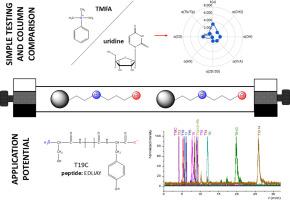Interaction properties and separation potential of zwitterionic stationary phases in hydrophilic interaction liquid chromatography
IF 3.2
引用次数: 0
Abstract
Two commercially available zwitterionic columns, one diol-based column and two newly developed experimental zwitterionic columns for hydrophilic interaction liquid chromatography (HILIC) were characterized and compared in terms of their interaction abilities. The novel HILIC columns offer mixed-mode cation-exchange and anion-exchange interactions together with minor hydrophobic contribution of alkyl spacers between the units.
Tanaka testing protocol, which provides complex information about column retentivity, hydrophobicity, hydrophilicity and cation/anion-exchange characters was performed. The results revealed the differences between individual zwitterionic stationary phases and clear predominance of cation-exchange character over anion-exchange character was observed for all tested columns. The measurements at different pH at various buffer salt concentrations revealed that the predominance of negative charge on the stationary phase surface occurs at pH 4.7 and higher (probably due to the dissociation of residual silanols). At lower pH (pH 3.0) the anion-exchange mechanism also applies. The cation-exchange character (applying across the whole pH range) has been further studied using other simple chromatographic tests and compared with >20 other commercially available columns. The application potential of all the tested columns was verified for analysis of tryptophan and its derivatives and also for cytochrome C tryptic digests.

亲水相互作用液相色谱中两性离子固定相的相互作用性质和分离电位
对两种市售两性离子柱、一种二醇基柱和两种新开发的实验两性离子柱进行了表征,并对其相互作用能力进行了比较。新颖的HILIC柱提供混合模式阳离子交换和阴离子交换相互作用,以及单元之间的烷基间隔剂的疏水性贡献。Tanaka测试方案提供了柱保持性、疏水性、亲水性和阳离子/阴离子交换特性的复杂信息。结果表明,两性离子固定相之间存在差异,阳离子交换特征明显优于阴离子交换特征。在不同pH和不同缓冲盐浓度下的测量结果表明,在pH为4.7或更高时,固定相表面的负电荷占主导地位(可能是由于残余硅烷醇的解离)。在较低的pH (pH 3.0)下,阴离子交换机制也适用。使用其他简单色谱测试进一步研究了阳离子交换特性(适用于整个pH范围),并与其他20种市售色谱柱进行了比较。验证了所有色谱柱在色氨酸及其衍生物分析和细胞色素C色氨酸消化分析中的应用潜力。
本文章由计算机程序翻译,如有差异,请以英文原文为准。
求助全文
约1分钟内获得全文
求助全文
来源期刊

Journal of chromatography open
Analytical Chemistry
CiteScore
2.50
自引率
0.00%
发文量
0
审稿时长
50 days
 求助内容:
求助内容: 应助结果提醒方式:
应助结果提醒方式:


